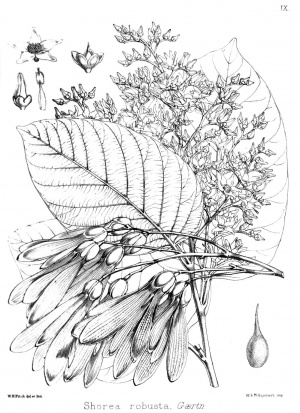Wikisage, the free encyclopedia of the second generation, is digital heritage
Shorea robusta: Difference between revisions
(o शाल) |
mNo edit summary |
||
| (2 intermediate revisions by the same user not shown) | |||
| Line 1: | Line 1: | ||
[[File:Shorea_robusta_Roxburgh_1819.jpg|thumb|left]] | |||
[[File:Sal_(Shorea_robusta)-_new_leaves_with_flower_buds_at_Jayanti,_Duars_W_Picture_120.jpg|thumb|left]] | |||
{| class="toccolours float-right taxobox pilze" style="font-size:80%;" cellpadding="3" cellspacing="3" | {| class="toccolours float-right taxobox pilze" style="font-size:80%;" cellpadding="3" cellspacing="3" | ||
| colspan="3" background-color:#000000;" | | | colspan="3" background-color:#000000;" | | ||
| Line 21: | Line 25: | ||
Shorea robusta, also known as śāl, sakhua or shala tree, is a species of tree belonging to the Dipterocarpaceae family. | Shorea robusta, also known as śāl, sakhua or shala tree, is a species of tree belonging to the Dipterocarpaceae family. | ||
Distribution and description | ==Distribution and description== | ||
New leaves with flower buds at Jayanti in Buxa Tiger Reserve in Jalpaiguri district of West Bengal, India. | New leaves with flower buds at Jayanti in Buxa Tiger Reserve in Jalpaiguri district of West Bengal, India. | ||
This tree is native to the Indian continent, ranging south of the East Himalaya, from Myanmar in the east to Nepal, Republic of India and Bangladesh. In India, it extends from Assam, Bengal, Odisha and Jharkhand west to the Shivalik Hills in Haryana, east of the Yamuna. The range also extends through the Eastern Ghats and to the eastern Vindhya and Satpura ranges of central India. It is often the dominant tree in the forests where it occurs. In Nepal, it is found mostly in the terai region from east to west, especially, in the Churia range (the Shivalik Hill Churia Range) in the subtropical climate zone. There are many protected areas, such as Chitwan National Park, Bardia National Park and Shukla Phat Wildlife Reserve, where there are dense forests of huge sal trees. It is also found in the lower belt of the hilly region and inner terai.<ref>Wikinfo</ref><references/> | This tree is native to the Indian continent, ranging south of the East Himalaya, from Myanmar in the east to Nepal, Republic of India and Bangladesh. In India, it extends from Assam, Bengal, Odisha and Jharkhand west to the Shivalik Hills in Haryana, east of the Yamuna. The range also extends through the Eastern Ghats and to the eastern Vindhya and Satpura ranges of central India. It is often the dominant tree in the forests where it occurs. In Nepal, it is found mostly in the terai region from east to west, especially, in the Churia range (the Shivalik Hill Churia Range) in the subtropical climate zone. There are many protected areas, such as Chitwan National Park, Bardia National Park and Shukla Phat Wildlife Reserve, where there are dense forests of huge sal trees. It is also found in the lower belt of the hilly region and inner terai.<ref>Wikinfo</ref><references/> | ||
Latest revision as of 01:49, 10 September 2016


|
शाल Shorea robusta Gaertn.[1] | ||
 | ||
|
Phylogeny | ||
| Ordnung | Malvales | Malvales |
| Familie | Dipterocarpa family | Dipterocarpaceae |
Shorea robusta, also known as śāl, sakhua or shala tree, is a species of tree belonging to the Dipterocarpaceae family.
Distribution and description
New leaves with flower buds at Jayanti in Buxa Tiger Reserve in Jalpaiguri district of West Bengal, India.
This tree is native to the Indian continent, ranging south of the East Himalaya, from Myanmar in the east to Nepal, Republic of India and Bangladesh. In India, it extends from Assam, Bengal, Odisha and Jharkhand west to the Shivalik Hills in Haryana, east of the Yamuna. The range also extends through the Eastern Ghats and to the eastern Vindhya and Satpura ranges of central India. It is often the dominant tree in the forests where it occurs. In Nepal, it is found mostly in the terai region from east to west, especially, in the Churia range (the Shivalik Hill Churia Range) in the subtropical climate zone. There are many protected areas, such as Chitwan National Park, Bardia National Park and Shukla Phat Wildlife Reserve, where there are dense forests of huge sal trees. It is also found in the lower belt of the hilly region and inner terai.[2]
- ↑ http://www.gbif.org/species/3189684
- ↑ Wikinfo
